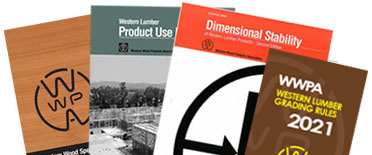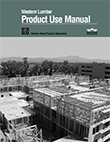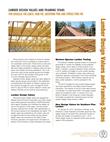
Design Values
Lumber Design Values
Design values provided herein are for Western softwood species manufactured and shipped by mills in the 12 contiguous Western states and Alaska. Except as otherwise noted, the values are computed in accordance with ASTM standards based on clear-wood tests or on tests of full-size pieces in specific grades. The applicable standards, based on results of tests conducted in cooperation with the USDA Forest Products Laboratory, are ASTM Standards D 2555 and D 245 for clear wood-based properties, and D 1990 for full-size test specimens.
The ASTM methods result in stiffness (E) values that are expected to be an average for the grades listed, while compression perpendicular-to-grain (Fc | ) values are mean-based. Test results for other properties are statistically evaluated per ASTM standards so that the strength levels listed are expected to be exceeded by 95% of the pieces in the various grades and sizes. Standard ASTM reductions have been made to values to account for safety and duration of load.
Mechanical Properties
Lumber strength properties are assigned to five basic properties: fiber stress in bending (Fb), tension parallel-to-grain (Ft), horizontal shear (Fv), compression parallel-to-grain (Fc), and compression perpendicular-to-grain (Fc | ). The modulus of elasticity (E) measures the amount a piece of lumber will deform in proportion to an applied load under elastic range stresses. It is a measure of stiffness and not a strength property.
Extreme fiber stress in bending values are calculated for pieces loaded on the narrow face for Beams & Stringers, and on either the narrow face or wide face for Dimension Lumber. Flat-use adjustments are provided for Beams & Stringers and Dimension Lumber, and depth-effect adjustments are provided for Structural Decking.
Fiber stress in bending values for the various grade classifications of Machine Stress-Rated (MSR) Lumber are based on the correlation of the modulus of rupture (MOR) to the modulus of elasticity (E). Machine output is controlled by testing pieces and adjusting the machines so the assigned Fb value (derived from a 5% exclusion level of MOR) is met after applying the same reduction factors for safety and duration of load as are applied to visually stress-graded lumber in accordance with ASTM Standards D 245 and D 1990. Design values appearing in the MSR Lumber section for Fc and Ft are based on tests of machine stress-rated lumber. Fc | and Fv values are the same as assigned by ASTM methods to visually graded No. 2 lumber of the appropriate species, except as noted.
Physical Properties Illustrated(Figures are available here)
Extreme Fiber Stress in Bending - Fb (Fig. 1). When loads are applied, structural members bend, producing tension in the fibers along the faces farthest from the applied load and compression in the fibers along the face nearest to the applied load. These induced stresses in the fibers are designated as "extreme fiber stress in bending" (Fb).
Single Member Fb design values are used in design where the strength of an individual piece, such as a beam, may be solely responsible for carrying a specific design load.
Repetitive Member Fb design values are used in design when three or more load-sharing members, such as joists, rafters, or studs, are spaced no more than 24" apart and are joined by flooring, sheathing, or other load-distributing elements. Repetitive members are also used where pieces are adjacent, such as decking. The lumber must be of the same size, species and grade or higher to qualify as a repetitive member.
Fiber Stress in Tension - Ft (Fig. 2). Tensile stresses are similar to compression parallel to grain in that they act across the full cross section and tend to stretch the piece. Length does not affect tensile stresses.
Horizontal Shear - Fv (Fig. 3). Horizontal shear stresses tend to slide fibers over each other horizontally and are most predominant in short, heavily-loaded deep beams. Increasing beam cross section decreases shear stresses.
Compression Perpendicular-to-Grain - Fc | (Fig. 4). Where a joist, beam, or similar piece of lumber bears on supports, the loads tend to compress the fibers. It is therefore necessary the bearing area is sufficient to prevent side-grain crushing.
Compression Parallel-to-Grain - Fc (Fig. 5). In many parts of a structure, stress grades are used where the loads are supported on the ends of the pieces. Such uses are as studs, posts, columns, and struts. The internal stress induced by this kind of loading is the same across the whole cross section and the fibers are uniformly stressed parallel to, and along the full length of, the piece.
Modulus of Elasticity - E (Fig. 6). The modulus of elasticity (E) is a ratio of the amount a material will deflect in proportion to an applied load.
About Framing Lumber Design Values
Dimension Lumber design values are published as BASE VALUES. BASE VALUES are constants that are applied to each grade in a particular species grouping. BASE VALUES must be adjusted for size, using the size adjustment factors.
Design values for other types of framing lumber are published in a SIZE-ADJUSTED FORMAT. Any special adjustments follow the appropriate tables of design values.
About Adjustments for Condition of Use
Allowable design values for wood members and connections in particular end uses shall be appropriate for the conditions in which the member is used, taking into account the differences in wood strength properties given the conditions of use. Standard adjustment factors are provide in the Western Lumber Product Use Manual. Consult the National Design Specification for Wood Construction (available from the American Forest & Paper Association) for additional design value adjustments such as temperature, pressure-preservative and fire-retardant treatment.





